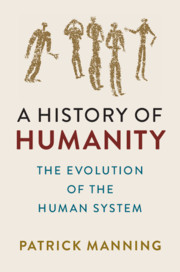Book contents
- A History of Humanity
- A History of Humanity
- Copyright page
- Contents
- Maps, Figures, and Tables
- Preface
- Acknowledgments
- Introduction
- Pleistocene Evolution
- Holocene Evolution
- 6 Society: Network versus Hierarchy
- 7 Collisions and Contraction
- 8 From Global Networks to Capitalism
- Anthropocene Evolution
- Appendix: Frameworks for Analysis
- Notes
- Glossary
- References
- Index
6 - Society: Network versus Hierarchy
from Holocene Evolution
Published online by Cambridge University Press: 14 February 2020
- A History of Humanity
- A History of Humanity
- Copyright page
- Contents
- Maps, Figures, and Tables
- Preface
- Acknowledgments
- Introduction
- Pleistocene Evolution
- Holocene Evolution
- 6 Society: Network versus Hierarchy
- 7 Collisions and Contraction
- 8 From Global Networks to Capitalism
- Anthropocene Evolution
- Appendix: Frameworks for Analysis
- Notes
- Glossary
- References
- Index
Summary
The “society” emerged in the warmth of the early Holocene, absorbing the preceding communities and confederations into institutions of more than a thousand members. The chapter contrasts two models of society, exploring whether diversity was beneficial or harmful. A cultural-evolution model places a premium on evolutionary unity within societies, so that each would maximize internal cooperation and fare better in conflict with others. A social-evolutionary model emphasizes diversity within society, favoring migration, multiple institutions, and tension of network and hierarchy. Further modeling of social evolution traces, society, its clans, and its elites, as both networks and hierarchies emerged in the institutions of agriculture, animal husbandry, artisanal workshops, towns, and judiciary. Some societies grew larger: they built states, measured time and created calendars. Agriculture supported cities but also sustained migrations: agriculture created enough greenhouse gases to warm Earth. Afro-Eurasian advances led the mid-Holocene in literacy, empires, water supply, and large-scale religion.
Keywords
- Type
- Chapter
- Information
- A History of HumanityThe Evolution of the Human System, pp. 109 - 144Publisher: Cambridge University PressPrint publication year: 2020

